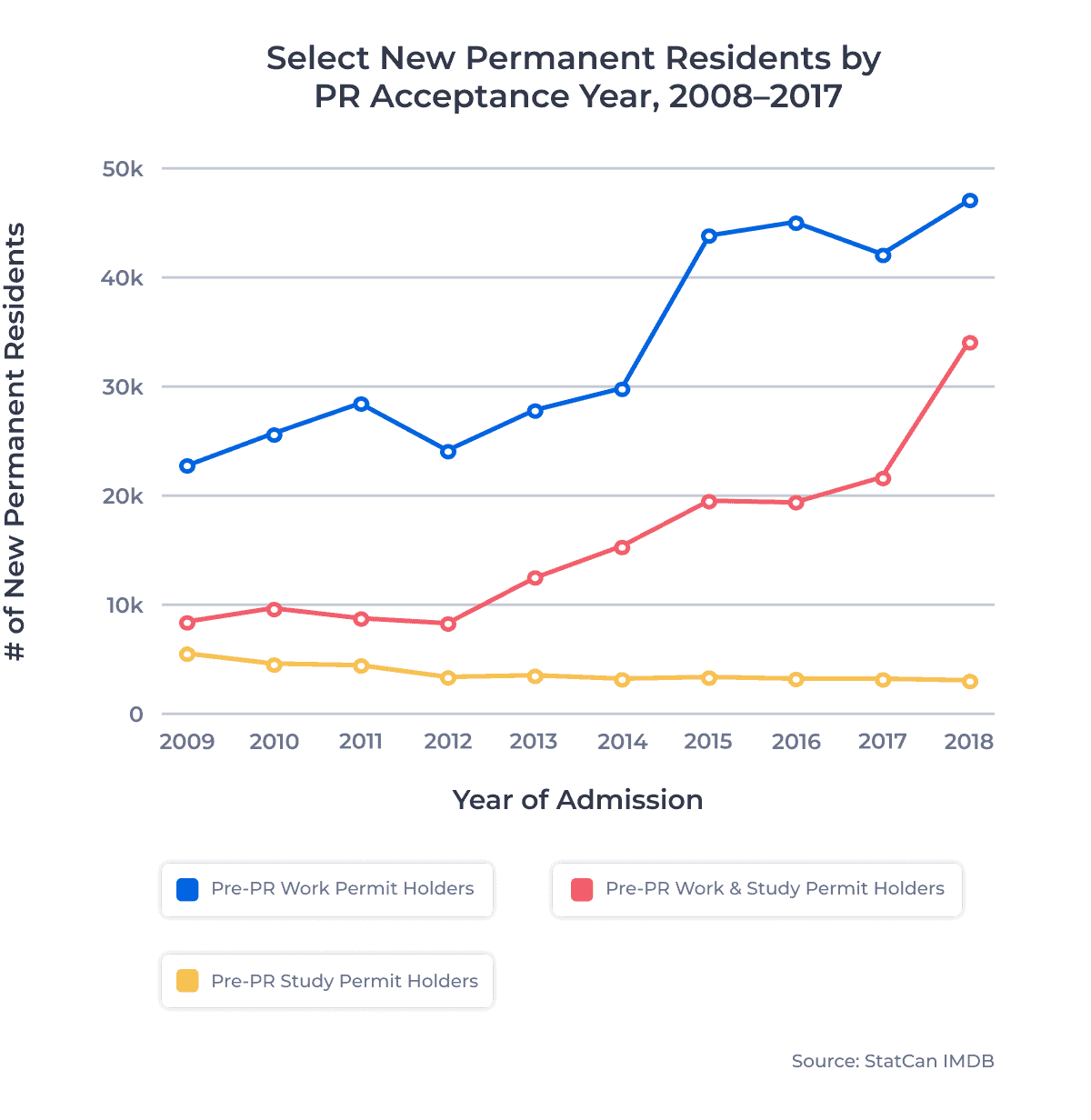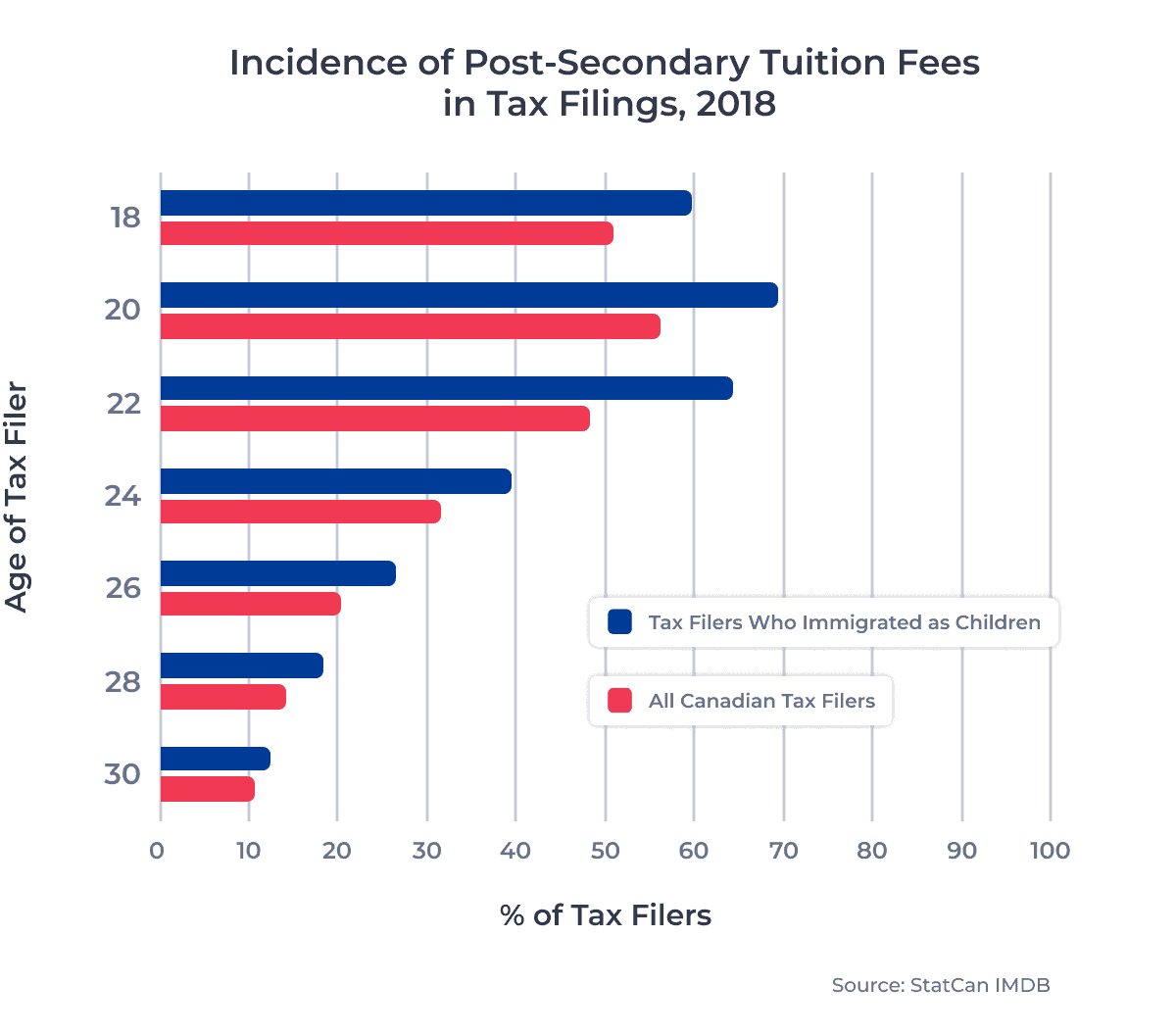While some international students plan to return home after they complete their studies, many consider studying abroad as the first step in their permanent residency (PR) journey. For those who go on to become permanent residents, their time as international students can provide invaluable skills and experiences which help them succeed in their careers and in their communities.
In this ApplyInsights, I’ll be digging into ways we can measure the impact of pre-PR1 international studies on Canadian permanent resident success long-term. Specifically, I’ll be analyzing pre-PR work and study permit data, as well as permanent resident income data, for new immigrants accepted into the Canadian permanent resident program between 2008 and 2017.2
First, I’ll take a look at pre-PR permit trends among new permanent residents over that period. Then I’ll examine average permanent resident incomes over time, and how different pre-PR experiences influence long-term earnings. Finally, I’ll dive into income and employment trends for individuals who immigrated to Canada as children compared to Canadian citizens.
Key Insights at a Glance
- The number of new permanent residents who were awarded work and study permits pre-PR has skyrocketed, growing 300% between 2008 and 2017.
- Permanent residents with both pre-PR work and study permits have higher average incomes than those with other pre-PR experience.
- Permanent residents who came to Canada as children are more likely to pursue post-secondary education and earn higher wages than Canadian citizens.
The data I’ll be referencing in this article comes from Statistics Canada’s Longitudinal Immigration Database (IMDB). Because this database combines immigration and tax filing information,3 it helps to provide a clear picture of permanent resident outcomes long-term.
Let’s start by looking at pre-PR work and study permit trends for new Canadian permanent residents.
Pre-PR Work and Study Permit Trends
In 2008, nearly 160,000 teenage and adult immigrants were granted Canadian permanent residency.4 Of this population, 14.1% received pre-PR work permits. By comparison, 3.5% of these residents received study permits and 5.2% received both work and study permits prior to admission.
By 2017, the number of new permanent residents5 with only pre-PR study permits had fallen by about half. But this did not represent a decrease in former international students receiving permanent residency. Rather, this decline was part of a significant spike in immigrants receiving both work and study permits before PR.
The chart below shows the number of new permanent residents per year6 who received work, study, or both work and study permits before they were accepted for PR between 2008 and 2017:
Research has shown that international students are less likely to be employed while studying, which can impact employment rates post-graduation. However, Canada’s PGWPP allows students to get valuable post-graduation work experience and thus increase their employability.
Find out more about working while studying abroad, or check out our blog post on post-secondary employment for international students.
Average Employment Incomes for Permanent Residents
The boom in international students who go on to secure work permits is a great sign for students considering Canada as a study abroad destination. Why? Because immigrants who secure both study and work permits prior to becoming permanent residents are statistically more likely to earn higher wages than any other permanent resident group.
Permanent residents who received their PR in 2008 earned an average income7 of around $23,0008 in 2009. By 2018, those same permanent residents had an average income of just over $35,000. But how did that compare to the income of those with pre-PR work or study permits?
The chart below shows the average income of new immigrants by the number of years since they received PR:
According to the graph above, new permanent residents with pre-PR study permits had a lower average income. However, it is important to note that this group includes youth aged 15-18 who may have reported minimal income. As well, the data contains post-secondary students who would have reported scholarships and school funding as income. Even so, the average income for pre-PR study permit holders exceeds the average for all new permanent residents from a given year within ten years.
Employability and Qualifications
According to a 2019 WES report, immigrants are more likely to be overqualified9 for their jobs than their Canadian peers. According to the 2016 census, immigrants were overqualified for their work in 30.9% of cases, compared to 9.3% of the time for Canadian-born individuals. One of the major roadblocks for immigrants looking for appropriate work is a lack of knowledge among employers about foreign education and employment credentials.
But immigrants with pre-PR experience as students or temporary workers also showed strong employment advantages over other immigrants. The report showed that immigrants with Canadian work experience were 240% more likely to be employed than those who immigrated through other economic PR categories. It also outlined that pre-PR work and studies helped older immigrants maintain their career level and industry after migrating.
International students have been called “ideal immigrants” by Canadian federal and provincial governments, given that these students are “well positioned to immigrate to Canada as they have typically obtained Canadian credentials, are proficient in at least one official language, and often have relevant Canadian work experience.”
Immigrant Children Experience Long-Term Success
We can see that adults and young adults who study abroad in Canada before becoming permanent residents are highly employable—and successful. This is especially true for those who are able to obtain a work permit before securing permanent residency. But studying abroad is not just beneficial to international students. Children who immigrate with their international student parents are also very successful, often attending post-secondary studies and gaining higher employment income.
First, let’s take a look at post-secondary tuition data for 2018.10 The chart below shows the frequency of post-secondary enrollment11 for all Canadian tax filers and tax filers who immigrated to Canada as children, based on their age in 2018:
Completing post-secondary studies is a key factor in increasing long-term earning potential and career opportunities. The following chart shows the median employment income of the same tax filers detailed in the post-secondary education chart:
Looking Forward
This data does not fully capture the lived experiences of every international student who has become a permanent resident. Many academics and researchers have dedicated significant time to evaluating the post-graduation success of international students. There are complex, competing factors that can significantly influence each student’s journey abroad.
But students considering studying abroad in Canada should take note of the huge benefits of post-secondary study and post-graduation employment in Canada. The PR pathway provided by Canadian study and work permits can lead to stable employment, higher income, and long-term success for students and their families.
My brothers and I can attest to the value of a Canadian education and how incredible it is to be part of Canada’s growing economy. We can also attest to the strength of the entrepreneurial spirit among international students. Many international students who can’t find a job create their own, driving Canada’s startup ecosystem and creating a brighter future for the next generation of Canadian citizens and immigrants.
With the growing popularity of the PGWPP, along with Canada’s world-leading vaccination rates, there’s never been a better time to study in Canada. Next month, I’ll be covering PGWPP trends and statistics in 2020 in more detail. Stay tuned!
Published: Jun 30, 2021
Subscribe to ApplyInsights
Sign up for the latest insights on international education.
 Meti Basiri
Meti Basiri
Co-Founder and Chief Marketing Officer (CMO)
Meti is driven by the belief that education is a right, not a privilege. He leads the International Recruitment, Partner Relations, and Marketing teams at ApplyBoard, working to make education accessible to people around the world. Meti has been instrumental in building partnerships with 1,500+ educational institutions across Canada, the United, the United Kingdom, and Australia. Working with over 7,500 international recruitment partners, ApplyBoard has assisted over 200,000 students in their study abroad journey. Follow Meti on LinkedIn for more access to ApplyInsights and key industry trends.
FOOTNOTES:
1. Pre-PR captures the period before the individual was granted permanent residency.
2. More recent data not available.
3. Immigration data in the IMDB is sourced from Immigration, Refugees, and Citizenship Canada (IRCC). Tax filing data in the IMDB is sourced from the Canada Revenue Agency (CRA).
4. Based on the total number of new permanent residents aged 15 and older who were accepted in 2008 and who filed taxes to the CRA in 2009.
5. Based on the total number of new permanent residents aged 15 and older who were accepted in 2017 and who filed taxes to the CRA in 2018.
6. Based on the total number of new permanent residents aged 15 and older who were accepted in that year and who filed taxes in the next fiscal year.
7. For the purposes of this article, “average income” in a given year is used to mean median employment income in that given year, unless otherwise noted. Statistics Canada has omitted tax filings with a total employment income value of $0 or $1 from the data set for the purposes of calculating median employment income in a given year.
8. All Canadian dollar values in this article are presented in 2018 Canadian constant dollars, unless otherwise specified. This allows for uniform comparison of employment income values across multiple years without further adjustments required for inflation.
9. Overqualified is defined in the WES report to mean immigrants who had university education but were working in positions requiring only high school or on-the-job training qualifications.
10. More recent data not available.
11. Based on the tax filer including tuition fees paid as part of their tax submission for the 2018 tax year.


